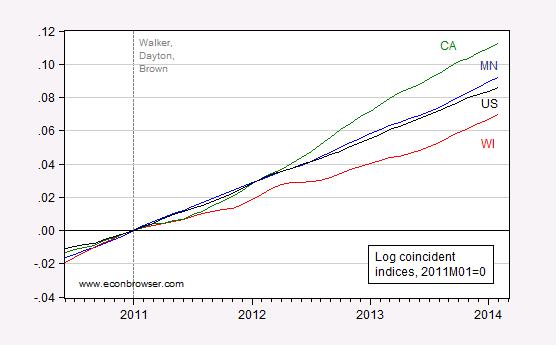Philadelphia Fed revised coincident indices released today show the cumulative Minnesota-Wisconsin gap (since January 2011) has grown to 2.3% (as of February, in log terms).
Moreover, in my 3/20 post on the Midwestern laggard (Wisconsin), I observed that the cumulative gap between Minnesota and Wisconsin was 1.8% as of January. The revised series released today indicate the cumulative gap between Minnesota and Wisconsin for January is now over 2.2% (vs. the previous 1.8%, both in log terms). Hence, Wisconsin’s underperformance was even larger than previously estimated.
Figure 1: Log coincident indices for Minnesota (blue), Wisconsin (red), California (green) and for the United States (black), all normalized to 2011M01=0. Source: Philadelphia Fed, and author’s calculations.
Data regarding Wisconsin’s lagging performance on nonfarm payroll employment, in this post.
Update, 4:40PM Pacific: dilbert dogbert suggests adding in Kansas. Lo and behold, Kansas’s (under)performance currently “rivals” that of Wisconsin.
Figure 2: Log coincident indices for Minnesota (blue), Wisconsin (red), California (green), Kansas (teal), and for the United States (black), all normalized to 2011M01=0. Source: Philadelphia Fed, and author’s calculations.
Dilbert dogbert refers the reader to this CBPP article:
Tax cuts enacted in Kansas in 2012 were among the largest ever enacted by any state, and have since been held up by tax-cut proponents in other states as a model worth replicating. In truth, Kansas is a cautionary tale, not a model. As other states recover from the recent recession and turn toward the future, Kansas’ huge tax cuts have left that state’s schools and other public services stuck in the recession, and declining further — a serious threat to the state’s long-term economic vitality. Meanwhile, promises of immediate economic improvement have utterly failed to materialize.


Menzie, you might want to graph Kansas too: http://www.cbpp.org/cms/index.cfm?fa=view&id=4110
Enjoy!
dilbert dogbert: Thanks for the link. I have added a graph. I don’t know if “enjoy” is the word — it is quite sad to see ideology triumph in economic self-immolation, but I did find it useful in illustrating how misguided these policies of massive tax cuts accompanied by slash-and-burn spending cuts are.
Two sets of data:
Milwaukee … http://www.bls.gov/eag/eag.wi_milwaukee_msa.htm
Minneapolis … http://www.bls.gov/eag/eag.mn_minneapolis_msa.htm
since the relative change over the past few years has been similar [note that I said relative change, not absolute levels], what is happening outside of the major metropolitan areas to account for the statewide gap?
Enjoy is what I use for a “Snark” icon.
Lots of natural experiments going on and it seems the results are being ignored.
I keep coming here and to Calculated Risk because you and Bill McBride will engage with your readers.
Keep up the interesting work.
Dilbert
Kansas indeed is an interesting experiment such was envisioned by the country’s Founders of states taking the lead in discovering optimal fiscal policies for its particular circumstances and being one of many laboratories that other states can learn and apply those policies which can be applied.
As for “results being ignored” that is not true on at least two levels. One – results are not yet comprehensively in unless you count an unemployment rate quickly dropping to 4.9% and two – speculation is rampant.
The state of Kansas probably is worth watching, but not as a comparison to Wisconsin and Minnesota since Kansas is significantly different in geography, population, and economic distribution of sectors. Example, how late the planting in the state from the norm could have a much greater impact on the state of the state than the fiscal policy changes.
I would like to know more about Kansas, but I suspect you are not from there and only are responding to other snarks of the progressive left who have come alive recently.
If you are from Kansas and happen to be an owner of a pass-through type business, I would truly like to see how the new state treatment of such is being implemented. Anyone else from Kansas?
Ed
I must have missed your blog spots about how Govern Walker’s admin took a 3.6 billion dollar deficit and turned it into a billion dollar surplus. What a brilliant job he’s done.
http://www.businessweek.com/ap/2014-01-17/wisconsin-budget-surplus-nears-1-billion
“But news of the $977 million surplus, which was expected for weeks but larger than many anticipated, set off a feeding frenzy in the Capitol among lobbyists, special interest groups and lawmakers.”
http://www.politifact.com/wisconsin/statements/2013/nov/15/scott-walker/gov-scott-walker-says-he-turned-36-billion-deficit/
“We rated False a claim by Democratic state Rep. Mark Pocan, who is now a member of Congress, that Walker’s $3.6 billion estimate was “a bogus figure.” Outside experts agreed that Walker’s number was reasonable.”
“I keep coming here and to Calculated Risk because you and Bill McBride will engage with your readers.”
Agreed. This and the relatively free speech. Scott Sumner does as well.
So Walker has a surplus and the economy has lagged. Who wins and who suffers from his actions? Isn’t the issue how his policies impacted the economy? What good is the surplus if the economy lags?